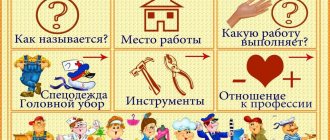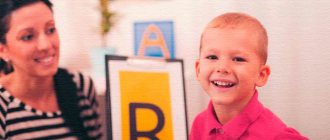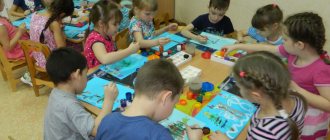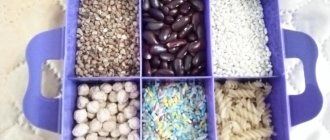Summary of frontal speech therapy lesson on the topic “Toys”
Summary of a frontal speech therapy lesson on the development of lexical and grammatical means of language for children OHP I period 1 according to the Approximate adapted program of correctional and developmental work in the speech therapy group of a kindergarten for children with severe speech impairments (general speech underdevelopment) from 3 to 7 years old N.V. Beggar
Subject:
"Toys"
Target:
To form lexical and grammatical means of the language based on the material of the lexical topic “Toys”
Educational results
:
Understand and use nominative and predicative dictionaries on the topic “Toys”
Understand personal pronouns you, he is in the process of a dynamic pause
Understand and use adverbs denoting the location of objects: here, there
Able to write simple, uncommon sentences
Tasks:
To develop the ability to understand and use nominative and predicative dictionaries on the topic “Toys”
Form an understanding of personal pronouns: you, he in the process of a dynamic pause
To develop the ability to understand and use adverbs denoting the location of objects: here, there
Develop the skill of composing a simple, uncommon sentence
Equipment:
Toys – bear, ball, doll, car; clothes for a doll, a toy bathtub, a set of toy dishes; split picture consisting of 3 elements; subject pictures with the image
Linguistic material:
Vocabulary for developing understanding (passive vocabulary): bear, ball, doll, car, feed, bathe, dress, ride, you, he, here, there, me
Vocabulary for use in active speech (active vocabulary): bear, car, ball, doll, toys, feed, ride, dress, bathe, here, there; I will feed, I will dress, I will ride, I will bathe
Progress of the lesson:
Organizing time:
Children sit on chairs in a semicircle.
Speech therapist: Hello, children! (a box is thrown into the group)
What is this box? What's in it? Get up from the chairs, go to the box (Children get up from the chairs and move to the box). Let's open this box together and see what's in it. (The speech therapist opens the box together with the children)
Main stage:
Speech therapist: So we opened the box. Let's see what lies here!
-This is a doll. She looks like a little person: she has eyes, hair, arms, legs.
I have a doll Masha - Everything looks like me! There is no more beautiful doll in the world, Only Masha is mine.
Speech therapist: Let's see who else we have in the box
-This is a bear. He has ears, eyes, a nose, paws, and a small tail.
This bear is the best - It feels pleasant to the touch, It has fluffy fur, It is very shaggy.
Speech therapist: And here is the next subject.
Frontal lesson in a preparatory speech therapy group
Frontal lesson in a preparatory speech therapy group on the topic: “Sound [w]”
Synopsis of a frontal lesson in a preparatory speech therapy group on the topic: “Sound [w]”
Author:
Naletova Ekaterina Anatolyevna, teacher-speech therapist at MDOU combined kindergarten No. 17, Podolsk, Moscow region
Description of the material:
The proposed material can be used in whole or in part by teachers - speech therapists of preschool educational institutions working with children with general speech underdevelopment in the preschool group (6-7 years old).
It's no secret that a child's oral speech deficiencies must be eliminated before school starts. Otherwise, the child is at risk of written language disorders such as dysgraphia and dyslexia. In order to prevent the above violations, the summary describes in detail work with children in a playful way, aimed at automating the sound [w] in preschoolers at different stages, developing general, fine and articulatory motor skills, facial muscles, as well as breathing and voice. Game exercises are presented to develop phonemic hearing and perception, improve the skills of sound-syllable analysis and synthesis, and develop word formation and inflection skills. Goals:
Correctional and educational: - consolidate the concept of the mechanism of sound formation [w];
- continue to teach children to give an acoustic-articulatory characteristic of the sound [w] based on various types of analyzers; - develop word formation and inflection skills. Correctional and developmental: - automate the sound [w] in children in syllables, words and sentences; - develop general, fine and articulatory motor skills; - develop breathing, voice, facial muscles in children; — develop phonemic hearing and perception; — develop sound-syllable analysis and synthesis; — clarify and expand the vocabulary; — develop attention and memory Correctional and educational: — cultivate self-control over speech in children; — to cultivate observation skills in children Equipment:
colored symbols for laying out sound patterns, plot pictures, a profile of the acoustic-articulatory image of sound [w], subject pictures depicting various types of transport and subject pictures for sound [w], sentence diagrams, the “Fun Train” manual ", multimedia board and projector.
PROGRESS OF THE CLASS
Organizing time:
-Today we have guests. Guys, what kind of transport do you think they used to get to our garden? The one who names any type of transport will sit.
1. Message about the topic of the lesson:
Game “4 extra”.
— I will name 4 types of transport, and you, please, select one extra one from them (plane, helicopter, car, hang glider). Explain why? An extra car, because it is ground transport, and an airplane, helicopter and hang glider are air transport. -Today we will go for a ride in a car and at the same time we will constantly monitor the correct pronunciation of the sound [w]. What sound in the word car did I highlight with intonation? -Sound [w]. Characteristics of the sound [w] by articulatory and acoustic characteristics: -What do the lips do when we pronounce the sound [w]? - Lips are rounded. -Where is the tongue? - Behind the upper teeth. —Which language, narrow or wide? -The tongue is wide, cupped. - Is there an obstruction in the mouth? -The tongue creates a barrier, which means the sound [w] is a consonant. -Does [sh] sound hard or soft? -The sound [w] is always hard. -How do we pronounce the sound [w], with or without voice? The sound [w] is a consonant, always hard, dull sound. The child at the board indicates the sound [sh] with a color symbol.
2. Development of phonemic hearing.
Isolating the sound [w] in a series of sounds (зь, сь, ч, Ш, щ, з, s, Ш, ц, Ш...) -I will pronounce similar sounds, and you clap your hands when you hear the sound [w].
3. Automation of the sound [w] in words and sentences.
- I will name the word, and you replace the first sound in it with the sound [w] and name the resulting word. Slipper - hat Heat - jackal Gift - ball Cup - checker Flank - hose Soap - awl Stomp - whisper Joint - bayonet Lips - fur coats Mouse - bump Pity - shawl Magician - step At the same time, the meaning of new words is explained.
4. Determining the position of the sound [ш] in words.
Game "Fun Train". — In the first carriage there will be passengers whose names have the sound [ш] at the beginning of the word, in the second - in the middle, in the third - at the end of the word. In the word cap, the sound [ш] is at the beginning of the word. Game “The Word Got Lost” - I will read poems to you, and if I mix something up, you correct my mistake • My friend and I played ……cups. We drank tea from a white…… checker. • She crawled out of the hole…..a bump and a mouse fell on her. • My sister and I sewed dishes... And washed outfits for dolls... • Weeping bitterly...... the poor balloon The balloon flew away..... Garik The balloon flew away. Let's make a diagram of the last sentence. How many words are there in a sentence? What's the first word? What's the last word?
5. Dynamic pause.
Speech with movement. Cars are rushing madly. -sho-shu palms with a megaphone This is the tire whispering to the tire: “I’m not in a hurry anymore - shu-shu” as you exhale, with a decrease in the strength of the voice
6. Syllable-sound analysis.
- A BEAR came to us in a car whose tire had burst. While the tire is being sealed in the auto repair shop, we will post a syllable-sound analysis of the word BEAR. Child at the blackboard: bear is one word. It has 2 syllables: mish-ka In the syllable MISH-: The first sound [m`] is a consonant, soft, voiced sound. I'll mark it with a green square. The second sound [and] is a vowel sound, I will denote it with a red square. The third sound [w] is a consonant, always a hard, dull sound, I will denote it with a blue square. In the syllable -KA: The first sound [k] is a consonant, hard, dull sound, I will denote it with a blue square. The second sound [a] is a vowel sound, I will denote it with a red square. -How many sounds are there in the word bear? How many syllables? -What needs to be changed in the sound scheme so that we get the word CAT? -We need to remove the first green square and put a blue one, because in the word CAT the first sound is K - a consonant, hard, unvoiced sound.
7. Formation of the lexical and grammatical structure of the language.
There's a knock on the door. They bring an envelope. -Guys, they brought us a letter from Shpuntik. He writes that friends from Sunny City gave him a car along with special pictures. The pictures show actions that the machine can perform. Please help me name these actions. o the car drove up to the house o the car drove into the garage o the car drove away from the house o the car drove up the mountain o the car drove up to the garage o the car drove down the mountain o the car leaves the garage o the car crosses the river o the car comes around the corner Children take turns naming the actions cars that are depicted on the multi-media board. Game "Say the opposite". The children have plot pictures on their tables, and the one with the action opposite to what is shown on the screen answers. On the screen: the car drove down the mountain. The child replies: “My car drove up the hill.” Game "Guess the transport." Guessing objects by the names of their parts. — Body, cabin, wheel, steering wheel, headlights. - This is a car (picture on the screen) - Wings, cabin, tail, engine. - This is a plane. - Deck, anchor, cabin, stern, bow. - This is a ship. — Cars, compartments, electric locomotives. - This is a train. On the children's tables there are object pictures depicting various types of transport. The multimedia contains plot pictures depicting a highway, sea, railway and sky. Children correlate their subject picture with the plot picture on the screen. Child: The car is driving along the road, this is ground transport. A train travels on a railway, it is a railway transport. An airplane (helicopter) flies in the sky, it is air transport. A ship (boat, cutter) floats on water; it is water transport. The train travels to the metro, this is underground transport. A motorcycle (bicycle) rides on the road; it is ground transport.
Lesson summary
- What sound were we talking about today? Describe the sound [w]. — What types of transport do you know? To denote the sound [sh], in the next lesson we will get acquainted with the letter Ш.
We recommend watching:
Summary of educational activities in a compensatory preparatory group with severe speech impairments Summary of a combined speech therapy lesson in a preparatory group Summary of a lesson with children 6-7 years old. Automation of sound [Рь] Summary of an open speech therapy lesson in the preparatory school group “Meeting of Spring”
Similar articles:
Lesson summary – travel on the topic “School” in the preparatory group
Summary of the lesson “Take care of nature” in the preparatory group





